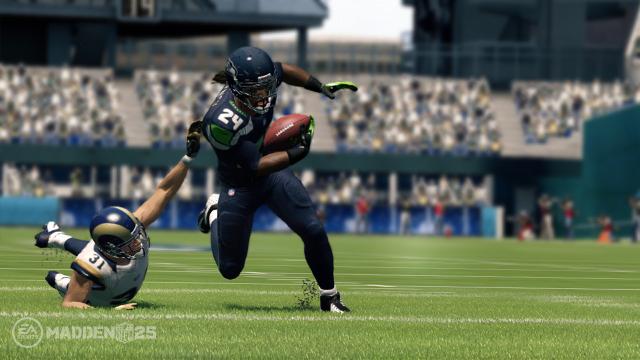Everyone sits on the turbo button in a sports video game. Its use was so ubiquitous, Madden‘s makers even removed turbo, before bringing it back. If the Madden NFL 25 demo is any indication, players will now clamp on two triggers: good old turbo, or a “precision modifier” that didn’t exactly win me over when I tried it.
That’s my takeaway after playing the Madden NFL 25 demo, released today on Xbox Live and PlayStation Network. I did not go to E3, and if I had and played Madden there, maybe my introduction to this new means of running the ball wouldn’t have been as brow-furrowing as it was this afternoon. It took me a good hour in the demo’s skills trainer — most of it just fooling around and deliberately failing the tutorial’s instructions — to understand that I must now hang on to the left trigger — the anti-turbo, basically — to juke the defence and then step on the gas with the right after I made my man miss.
This blog post by EA Sports outlines the conceptual differences between modified and unmodified special moves — yes, you may still dive with the X/square button, but a modified dive makes him dive for every last inch, as if there was some strategic need for not diving for as long of a gain as possible. A modified spin will make your ballcarrier protect the ball.
To me, though, this precision modifier either increases the effectiveness of a special move or the window in which it can be successfully executed. The stiffarm was the greatest example of this, not just in the tutorial but also in the live games I played. If I was running between the tackles, I clamped on the left trigger and put my hand out, and still would power defenders into the ground despite telegraphing the move. You still need to be angled properly, and Marshawn Lynch and Frank Gore (whose teams are two of the four appearing in the demo) are power runners highly rated for this particular talent.
“Precision running,” seems to offer a reasonable choice: left trigger for to make your guy miss his tackle, or right trigger to run away from him. That’s why I’m wondering why anyone would ever run the ball without either squeezed.
I perceived little to no change in player speed and momentum with the left trigger/”precision modifier” engaged or not, so there seems to be no penalty for employing it prophylactically until you have to hit the gas. The new physics engine introduced last year also introduced more ways for your ballcarrier moves to be interrupted or defeated. So they had to be augmented without becoming superhuman, and that seems to be the goal here.
Fine. But loading that obligation onto the user with an extra command will take a lot of trial and error — and the running tutorial is ill-equipped to deliver that. Besides, as I discovered with NCAA Football 14, the upgrades to basic momentum make turning, stopping and bursting for speed with the unaided left stick effective enough on most runs.
You’ll see momentum on display in other plays too, particularly hook routes and comebacks, which were very effective in the games I played (for and against me). Defensive backs are easily shaken off when a receiver stops his route and faces his quarterback. In one game, an AI Aaron Rodgers completed his first 12 passes; in another, Joe Flacco completed 10 straight to close out the first half with a touchdown. It helps that I’m naturally bad on pass defence, but my best hope for frustrating a pass attempt was sacking or hurrying the quarterback as opposed to doing anything with the defensive backs. Of course, on offence momentum worked in my favour, too, provided the receiver wasn’t jammed at the line.
The main camera angle is different, more pulled back — frequently screening off when your defender is about to engage you, which may be why the precision-modified window is so wide open (I played on veteran difficulty). Presentational elements seem more polished and the commentary of Jim Nantz and Phil Simms isn’t as predictable as last year’s game. As for run blocking, I really can’t judge that without replay (none is available in the demo) and besides, I was mostly fixated on executing special moves. You’ll get smoked from the edges and tackled from behind more than in NCAA Football, but this is the NFL, where every team has a defensive end that can run down a gazelle.
Giving impressions of a video game demo is a tricky and possibly unfair evaluation as you’re most likely getting a very early build of the game and, of course, you see none of the career modes, in which gamers spend 99 per cent of their time. As annual products, though, sports video games have a greater obligation to differentiate and refine their gameplay year-to-year (where other annual series do so through maps or new characters). So an evaluation of the gameplay, even in a demo, is warranted.
On these merits, Madden is different, yes, by introducing that precision modifier. I recommend getting the demo and just screwing around in the skills trainer (as no practice mode is available) to understand it for yourself. Also, if the trainer boots without any instruction in your running tutorial (this happened to me twice), quit out and load it again.
But the NFL is a high speed game and Madden now expects you to add another command to a a split-second decision to gain your first down or extend the play. After coming to grips — literally — with this, my impression is that the things Madden‘s demo didn’t show, like it’s career mode enhancements, is what will keep me engaged after the game arrives on August 27.

Comments